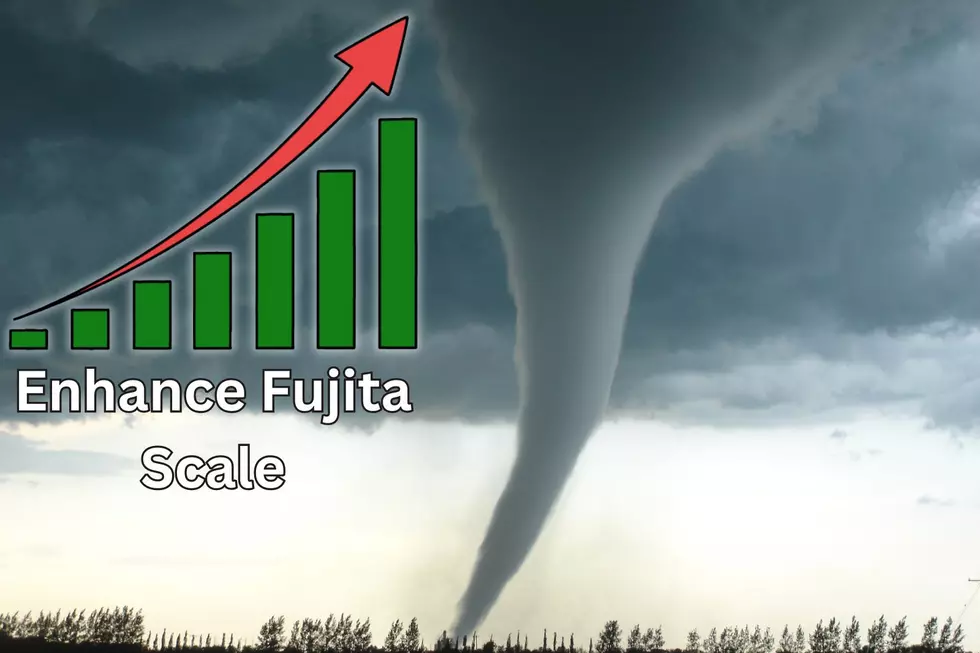
Two Monster Oklahoma Tornadoes Are Inspiring EF-Scale Changes
I think it's fair to say most people in Oklahoma are familiar with at least one of the scales we use to determine the severity of a tornado.
Older generations know it as the F-Scale, others know it as the EF-Scale.
Originally, when Ted Fujita wrote the book on tornado damage, it measured mostly windspeed. At the time, the Fujita Scale went all the way to F12--the speed of sound--because in the early days of tornado science, it was believed twisters produced winds fast enough to make a sonic boom due to how houses and buildings seemed to explode.
That's where the idea of opening windows during a storm came from too... A horrible idea all around.
After the 'Granddaddy' May 3rd Bridge Creek-Moore F5 that swept through portions of the OKC metro back in 1999, meteorologists pushed for a change to the Fujita Scale to bias ratings more towards damage. After all, that storm could have been classified as an F6 based on windspeed alone--something that didn't sit well with the scientific community.
The Enhanced Fujita Scale is what came about during the great tornado debate of the early 21st Century. A scale limited to six categories--from EF-0 to EF-5--with a very weighted influence on damage and destruction instead of windspeed. As most meteorologists agree now, it's not perfect.
Case and point.
It was the even bigger May 2013 El Reno twister that started the belief that the Enhanced Fujita Scale wasn't accurate and was in need of another revamp.
Here was this tornado, the biggest our world has ever seen, and because it happened out in the middle of nowhere, it was classified as a "strong" EF-3 because only a handful of structures were damaged. It killed 8 people and injured 151.
Even though it was 2.6 miles wide with the second-highest ever recorded windspeed and a damage path a little over 16 miles long, it couldn't be an EF5 because it didn't do enough damage rolling through a mostly unoccupied part of the county.
There is another tornado now on record that has the meteorological community calling for a change to the Enhanced Fujita Scale, and it happened only days ago in Southwest Oklahoma.
Tornado Outbreak 2024
Oklahoma has experienced tornado-producing weather (at the time of publishing) four of the last six calendar days. The main headlines are those tied to the April 27th storms in Ardmore, Sulphur, and Marrietta, but the data from another twister in the middle of nowhere is coming to light.
On Tuesday, April 30th a monster tornado ripped through the countryside near Hollister, Oklahoma.
The good news is, it was mostly farmland and damage was limited to a few roofs, but it was unlike the overwhelming majority of twisters.
Not only was it erratic in the path, it spun backwards--anti-cyclonic--which made for really entertaining weather coverage on TV.
Why is this tornado going to be responsible for a change to the EF-Scale?
Simply put, the power of it. The Hollister tornado will be listed alongside the most powerful tornadoes on record, even though it has been rated an EF1 based on the limited damage.
What made it so powerful? The wind speed and velocity.
What would a further enhanced Enhanced Fujita Scale look like?
That's the debate. Since wind speeds alone didn't tell the whole tale of a twister, and only looking at the damage isn't working out very well either, there's talk of a hybrid scale that balances both.
A proposed new EF-Scale would classify a storm in both regards, so another EF3 El Reno "Biggest Tornado Ever" hit again, it would look different in the annals of history.
EF3 damage rating, since it happened in open country with little damage... but also an EF5 rating for size and wind speed.
New rating - EF3.5... or perhaps EF3/5. It's all where the punctuation goes at this point.
Odd and Unbelievable Tornado Facts
Gallery Credit: Kelso
Tornado Records from Around the Country
Gallery Credit: Kelso
The Ten Most Tornado-Prone Counties in America
Gallery Credit: Kelso




